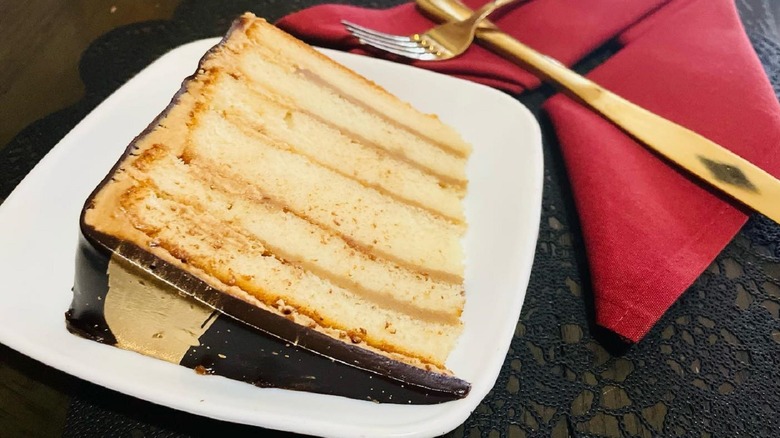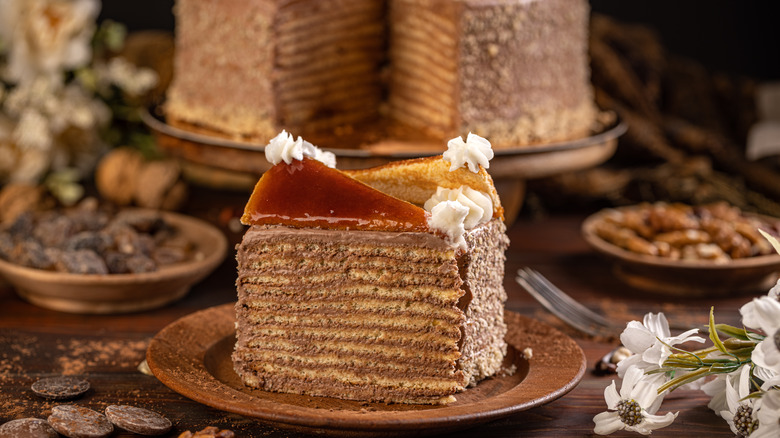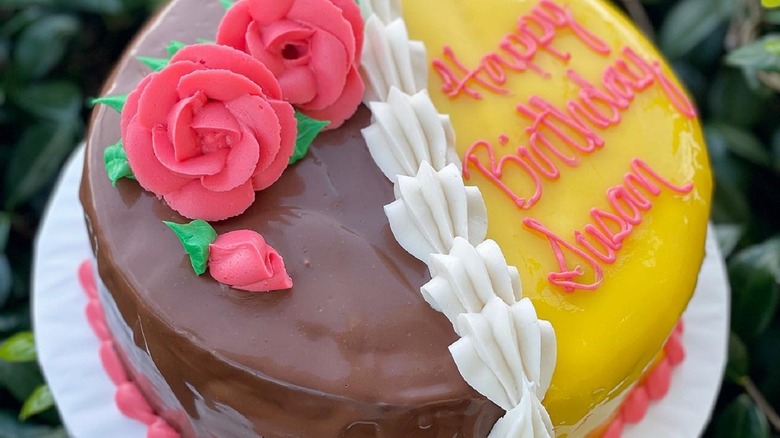Doberge Cake: The New Orleans Staple You Need To Try On Your Next Visit
If you aren't from New Orleans and someone asks you to associate the city with a cake, you'd likely jump directly to king cake — the brightly decorated cake often with a little hidden bean or plastic baby inside that's popular around Mardi Gras. But if you live in the area, you might have a different answer: The doberge cake.
A towering layer cake with thin layers of yellow butter cake divided by thin layers of custard, all swathed in buttercream and encased in fondant, the doberge cake is a favorite New Orleans celebration treat. The traditional custard flavors are chocolate, caramel, or lemon, but many people opt for a cake with half chocolate, half lemon. But it's the format that really matters in a doberge: Other bakers in New Orleans make doberge cakes that range from strawberry pistachio to peanut butter cup, but they're all made with many layers of custard filling (typically anywhere from 6-fifteen), decorated in buttercream (and sometimes finished with fondant). And in New Orleans, it's been the go-to birthday cake for almost ninety years.
The father of the dobos and the queen of the doberge
The doberge cake was created by Beulah Ledner sometime around 1935. The granddaughter of a German Jewish baker, Ledner took inspiration from the Austro-Hungarian dobos torte. Created in the late 1800s by a Hungarian baker in Budapest named József C. Dobos, the dobos torte was meant to not only be more stable than other cakes, but also maintain its freshness longer. József thinly layered sponge cake with buttercream and then coated it with caramel. These buttercream and caramel layers helped to keep the sponge from drying out.
Ledner, though, was in hot, sticky New Orleans. According to her daughter Maxine, Beulah — the "Doberge Queen of New Orleans" — had intuited that, even with a noted sweet tooth, the average New Orleanian would prefer something lighter on the palate. Rather than heavy buttercream between layers, she opted for the lighter texture and weight of custard and named it doberge to credit the French influence of New Orleans. And people loved it.
Secrets of the doberge cake
There are two original recipes from Beulah Ledner still floating around: One linked to a bakery called Gambino's and another to Maurice French Pastries. Back in 1946, Beulah sold her bakery — and all her recipes — to Gambino's. However, after some time she opened a new bakery, which was then purchased by Maurice in the 1980s after Beulah retired. There are a few reasons circulating as to why Ledner sold in '46, ranging from the advice of her doctor after a heart attack to supply issues during World War II, or maybe even a combination of the two. Either way, two bakeries claim to be baking from Ledner's original recipe.
Now, there are quite some definitive specifications of this southern specialty. Ledner's son Albert says the layers have to be ⅜ of an inch. There should be between six and eight layers, separated by custard, making for a total alternating stack of eleven to fifteen layers. Ledner's granddaughter, Catherine, claims that when done right, it looks like "a pinstripe shirt on the inside." Vincent Scelfo, owner of Gambino's, and Albert Ledner both say Beulah knew the secret to getting it right was baking each layer individually. This prevented the layers from absorbing the custard. Although the process of making a doberge cake was labor intensive, and Beulah didn't see much money from her endeavors, she did it because it was "the way it should be done."


